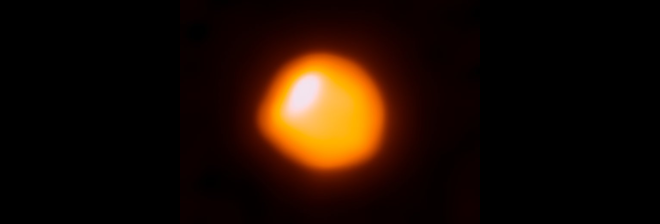Articles by HAS Members
Fun Fact - How many Suns would fit into Betelgeuse?
by Jonathan Park
This article appeared in the August 2023 HAS newsletter.
Image: Betelgeuse (accepted pronunciation is "beetle-juice") as imaged by the Atacama Large Millimeter/submillimeter Array (ALMA).
You may know that about 1.3 million Earths would fit inside our Sun. But how many stars the size of our Sun would fit into the red supergiant star Betelgeuse? It depends on how big Betelgeuse is, and because the distance to Betelgeuse is uncertain, its size is difficult to determine accurately. Betelgeuse is also a pulsating star, so its radius increases and decreases slowly, around an average size.
In any case, Betelgeuse is huge, and it's not unreasonable to say that it might have a radius of around 750 million kilometres. This would give it a diameter of about 1.5 billion kilometres. The distance to Jupiter from our Sun is nearly 778 million kilometres, so in this case, if we replaced our Sun with Betelgeuse, it would fill the Solar System out to about 96% of the way to the orbit of Jupiter. Based on this, we could squeeze about 1.2 billion stars the size of our Sun inside Betelgeuse.
For those who want to see the math, here it is:
> Radius Betelgeuse guessed: RB ≈ 750,000,000 km
> Radius of the Sun: RS ≈ 700,000 km
> Volume of a sphere = 4/3πr3
> The 4/3π cancels out, so the volume ratio is:
> (RB/RS)3 = (750,000,000 / 700,000)3 = 1,229,956,268, close to 1.2 billion.
This of course ignores the fact that stacking spheres leaves some gaps - so we really are "squishing" stars into this volume!
What is the Atacama Large Millimeter/submillimeter Array (ALMA)?
Here's their website: https://www.eso.org/public/teles-instr/alma/
More information about Betelgeuse:
Distance to Betelgeuse = 197 ± 45 pc = 642 ± 146 light years
https://arxiv.org/abs/2306.09449
An interesting (but technical) paper about Betelgeuse
https://iopscience.iop.org/article/10.3847/1538-4357/ac4f5f

